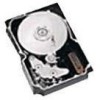Seagate ST39204LC Product Manual - Page 27
Drive Self Test DST
 |
View all Seagate ST39204LC manuals
Add to My Manuals
Save this manual to your list of manuals |
Page 27 highlights
Cheetah 18XL Product Manual, Rev. G 17 not exceed the threshold before the interval expires, then the error rate is considered to be acceptable. In either case, the interval and failure counters are reset and the process starts over. Predictive failures S.M.A.R.T. signals predictive failures when the drive is performing unacceptably for a period of time. The firmware keeps a running count of the number of times the error rate for each attribute is unacceptable. To accomplish this, a counter is incremented whenever the error rate is unacceptable and decremented (not to exceed zero) whenever the error rate is acceptable. Should the counter continually be incremented such that it reaches the predictive threshold, a predictive failure is signaled. This counter is referred to as the Failure History Counter. There is a separate Failure History Counter for each attribute. 5.2.9 Drive Self Test (DST) Drive Self Test (DST) is a technology designed to recognize drive fault conditions that qualify the drive as a failed unit. DST validates the functionality of the drive at a system level. There are two test coverage options implemented in DST: 1. Extended test 2. Short text The most thorough option is the extended test that performs various tests on the drive and scans every logical block address (LBA) of the drive. The short test is time-restricted and limited in length-it does not scan the entire media surface, but does some fundamental tests and scans portions of the media. If DST encounters an error during either of these tests, it reports a fault condition. If the drive fails the test, remove it from service and return it to Seagate for service. 5.2.9.1 DST Failure Definition The drive will present a "diagnostic failed" condition through the self-tests results value of the diagnostic log page if a functional failure is encountered during DST. The channel and servo parameters are not modified to test the drive more stringently, and the number of retries are not reduced. All retries and recovery processes are enabled during the test. If data is recoverable, no failure condition will be reported regardless of the number of retries required to recover the data. The following conditions are considered DST failure conditions: • Seek error after retries are exhausted • Track-follow error after retries are exhausted • Read error after retries are exhausted • Write error after retries are exhausted. Recovered errors will not be reported as diagnostic failures. 5.2.9.2 Implementation This section provides all of the information necessary to implement the DST function on this drive. 5.2.9.2.1 State of the drive prior to testing The drive must be in a ready state before issuing the Send Diagnostic command. There are multiple reasons why a drive may not be ready, some of which are valid conditions, and not errors. For example, a drive may be in process of doing a format, or another DST. It is the responsibility of the host application to determine the "not ready" cause. While not technically part of DST, a Not Ready condition also qualifies the drive to be returned to Seagate as a failed drive. A Drive Not Ready condition is reported by the drive under the following conditions: • Motor will not spin • Motor will not lock to speed















